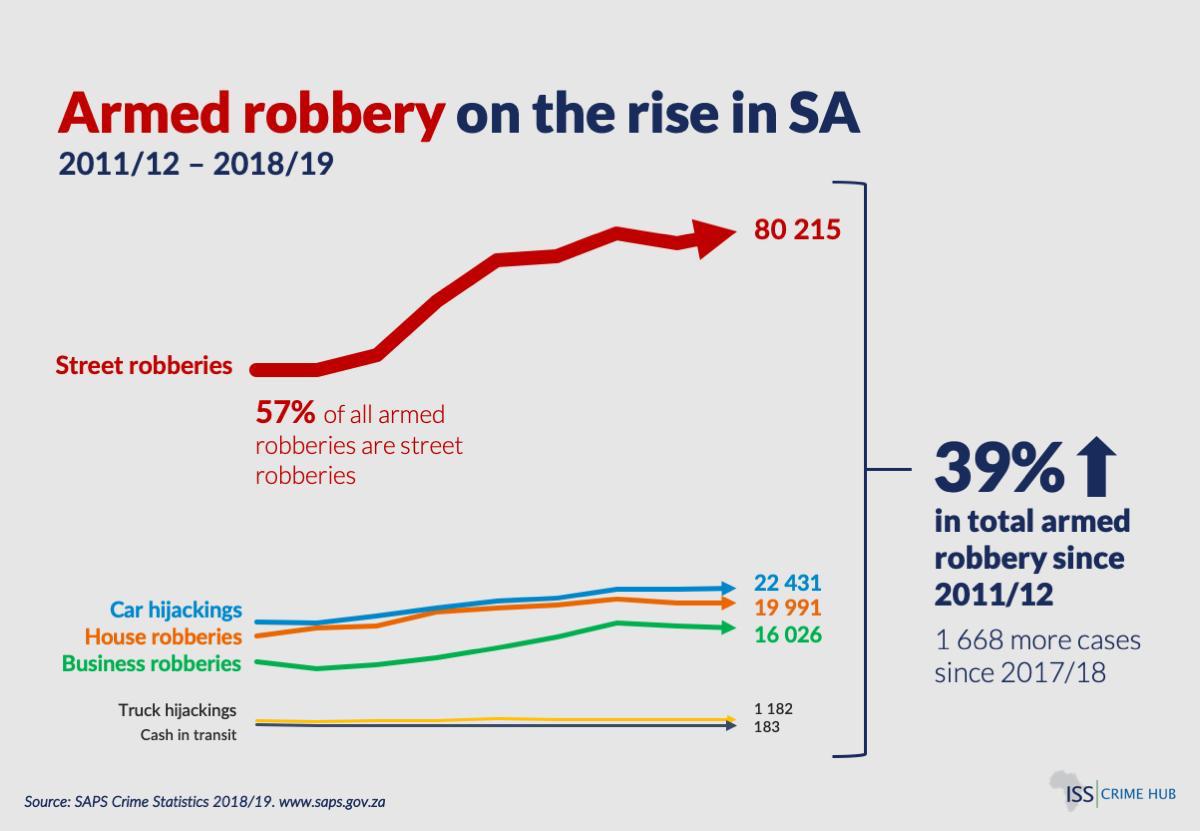Why police should focus on street robberies
In what is a largely ignored problem in South Africa, many street robbers graduate to car hijacking and home robbery.
While the media tends to focus on South Africa’s high-profile robberies such as cash-in-transit heists, mall robberies and house robberies, the far larger problem of ‘street robbery’ is mostly ignored – not just by the media but by law enforcement. Policing strategies could go a long way in preventing this type of crime.
The lack of attention on street robbery is problematic for victims. It also means that more serious attacks like hijacking and home robberies will continue to rise, as the perpetrators are often the same.
Street robberies affect many more people than other types of robbery in South Africa and have been soaring for seven years. According to the latest South African Police Service (SAPS) crime statistics for April 2018 to March 2019, 140 032 cases of aggravated (or serious armed) robbery were recorded. Most of these armed attacks (57%) can be described as street robberies – perpetrated against people walking in the streets or other public places (Figure 1).
 Figure 1: Aggravated robbery trends, 2011/12 – 2018/19 Figure 1: Aggravated robbery trends, 2011/12 – 2018/19 (click on the graphic for the full size image) |
The police don’t distinguish this type of robbery from other categories of robbery, rendering street robbery largely invisible in the police statistics. This is so despite the police receiving reports of 80 215 street robberies – an average of 220 a day – in 2018/19.
The types of aggravated robbery that the police instead focus and report on are carjacking, truckjacking, house and business robberies, and bank and cash-in-transit robberies. These six classifications make up 43% of all aggravated robberies reported to the police.
It is not only most serious or aggravated robberies that take place on the streets and in public. The bulk of the 51 765 ‘common robberies’ reported to police in 2018/19 also occurred on the streets. (These are crimes in which the victim is threatened with physical harm but without the use of a dangerous weapon.)
The SAPS classifies robberies as crimes committed by one or more armed perpetrators who directly use, or threaten a victim with, violence in order to steal their belongings. Robbery leaves the victim not only with the loss of hard-earned valuables but also psychological trauma. It can lead to physical injury or death.
Despite the seriousness of street robberies, most go unreported. According to the recent Victims of Crime Survey, almost two out of three (65.3%) victims of street robberies do not report the attack to police. The high under-reporting rate is probably due to victims believing the police are incapable of resolving the crime.
The police don’t distinguish street robberies, rendering them largely invisible in the statistics
Street robbers pick the place and their potential victims carefully. Their selection is often based on the availability of vulnerable targets and quick escape routes. These spots are usually dark, overgrown or desolate walkways used by pedestrians to move to and from transit hubs, public services, schools or shopping centres. It is for this reason that a person is more likely to be a victim of a street robbery in a business node or densely populated area.
The top five high-risk police precincts in South Africa for aggravated street robberies are Johannesburg Central, Hillbrow, Khayelitsha, Nyanga and Durban Central. The robberies are not evenly spread across these precincts but are concentrated in micro-locations identifiable through hotspot analysis. Furthermore, most robberies are committed by a relatively small number of repeat offenders.
Good policing can be particularly effective to prevent street robbery. Problem-oriented policing strategies that develop responses to this specific crime at local level would be useful. More precise data is also needed on where and how the crimes take place. This information should be methodically captured, mapped and verified. Used consistently over time, emerging trends and hotspots can then be analysed. Data-driven decision making will ensure more rational planning and deployment of resources.
Accurate data is needed not just for good planning, but also for monitoring and evaluation. Police station managers should also share information with the public to enable them to keep themselves safe, support safety interventions, and improve perceptions of police accountability. This in turn helps grow public trust and confidence in the police.
Street robberies affect far larger numbers of people than other types of robbery in South Africa
Detailed anti-street robbery strategies are also needed. This requires a collaborative approach ideally driven by local crime intelligence officers who identify patterns, trends, modus operandi and develop detailed offender profiles. Dedicated detectives should arrest offenders and gather adequate evidence to support convictions. Targeted visible police patrols, both foot and vehicle, can deter and prevent potential crimes.
While robbery can be substantially reduced by effective policing, communities can also help improve their own safety. This can be done through neighbourhood watches, community policing forums and disrupting the market for stolen goods by increasing awareness or simply not buying such goods.
Environmental considerations such as improved street lighting, closed-circuit television and removing overgrown grass to eradicate hiding spots are also useful. Evidence shows that if carried out carefully and methodically, these measures can work to reduce street robbery.
Street robberies are the entry point for many career criminals who move on to more sophisticated endeavours such as hijacking, home and business robberies. A focus on street robberies will have a positive impact on crime and violence levels and improve public feelings of safety.
To check crime trends in your area, visit the ISS Crime Hub: https://issafrica.org/crimehub/.
Lizette Lancaster, Manager, Crime Hub and Stuart Mbanyele, Junior Researcher, ISS Pretoria
In South Africa, Daily Maverick has exclusive rights to re-publish ISS Today articles. For media based outside South Africa and queries about our re-publishing policy, email us.
Photo credit: commons.wikimedia.org

